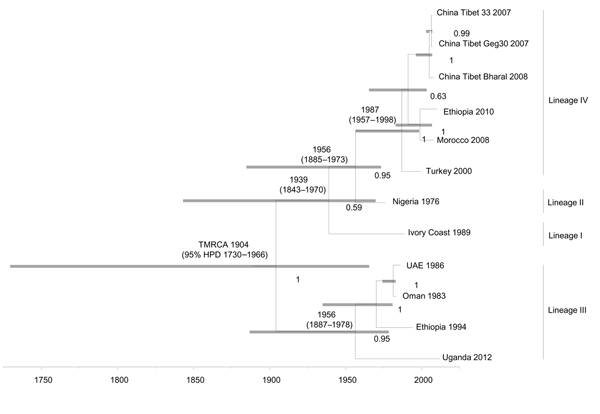Molecular Evolution of Peste des Petits Ruminants Virus
Murali Muniraju, Muhammad Munir, AravindhBabu R. Parthiban, Ashley Banyard, Jingyue Bao, Zhiliang Wang, Chrisostom Ayebazibwe, Gelagay Ayelet, Mehdi El Harrak, Mana Mahapatra, Geneviève Libeau, Carrie Batten, and Satya Parida

Author affiliations: The Pirbright Institute, Pirbright, UK (M. Muniraju, M. Munir, M. Mahapatra, C. Batten, S. Parida); National Institute for Animal Biotechnology, Hyderabad, India (A.R. Parthiban, S Parida); Animal Health and Veterinary Laboratories Agency, Weybridge, UK (A.C. Banyard); China Animal Health and Epidemiology Centre, Qingdao, China (J. Bao, Z. Wang); National Animal Disease Diagnostics and Epidemiology Centre, Entebbe, Uganda (C. Ayebazibwe); National Veterinary Institute, Debre Zeit, Ethiopia (G. Ayelet); Société de Productions Pharmaceutiques et Vétérinaires, Rabat, Morocco (M. El Harrak); Le Centre de Cooperation Internationale en Recherche Agronomique pour le Développement, Montpellier (G. Libeau)
Main Article
Figure 2

Figure 2. Time-scaled Bayesian maximum clade credibility phylogeny tree based on peste des petits ruminants virus complete genome sequences. The tree was constructed by using the uncorrelated exponential distribution model and exponential tree prior. Branch tips correspond to date of collection and branch lengths reflect elapsed time. Tree nodes were annotated with posterior probability values and estimated median dates of time to most recent common ancestor (TMRCA). Corresponding 95% highest posterior density (HPD) interval values of TMRCA are indicated as gray bars. Horizontal axis indicates time in years. UAE, United Arab Emirates.
Main Article
Page created: November 18, 2014
Page updated: November 18, 2014
Page reviewed: November 18, 2014
The conclusions, findings, and opinions expressed by authors contributing to this journal do not necessarily reflect the official position of the U.S. Department of Health and Human Services, the Public Health Service, the Centers for Disease Control and Prevention, or the authors' affiliated institutions. Use of trade names is for identification only and does not imply endorsement by any of the groups named above.
